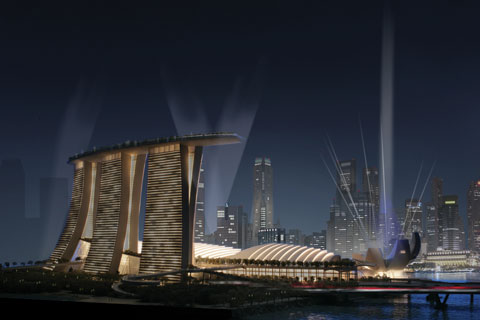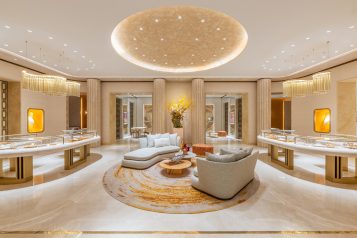With a multi-billion dollar investment getting off the ground, Las Vegas Sands is letting it ride on Singapore’s first ever casino resort
By Michael Calderone
Marina Bay, a scenic cove located just east of Singapore’s vibrant downtown, is undergoing a radical transformation. Luxurious real estate developments are beginning to take shape, and not surprisingly, business travelers and leisure seekers from around the globe are flocking to this burgeoning hot spot.
For years, many westerners have associated the Asian city-state with harsh enforcement of laws, and little tolerance for such grand displays of wealth. But now the government is loosening up the rules, while at the same time, investing heavily in urban development. Since 2005, the government has spearheaded projects all around Marina Bay-improving transportation and creating a ritzy boulevard. Not to mention, opulent residential buildings and an 18-hole golf course have sprung up.
Although these projects are redefining Singapore from a “garden city” into a 21st century cosmopolitan center-“a city within a garden” as development advocates like to say-the most dramatic change is still to come. In 2009, Marina Bay Sands, a multi-billion dollar integrated resort, housing the country’s first casino will be completed and instantly turn Singapore into a premier destination for the world’s jet set travelers.
“Singapore wants to double tourism by 2015, and they decided that they were going to legalize casino gaming,” said Ron Reese, Executive Director of Communications of Las Vegas Sands.
Along the sprawling waterside promenade and shopping arcade, there will be a variety of high-end shops and chic boutiques.
That’s where his company comes in. Mr. Reese has traveled to Singapore at least a dozen times on behalf of Sands, meeting with forward-thinking business leaders and government officials, who are eager to boost the local economy. The one-of-a-kind, Marina Bay location inspired the Las Vegas casino chain to put all their chips down, so to speak. As Reese himself said, “I think Marina Bay is one of the coolest sites around.”
For Sands, which already owns the renowned Venetian Resort Hotel Casino in Las Vegas, obtaining the right to develop this premier property wasn’t easy. It required beating out stiff competition from the world’s leading hotel and casino companies.
Now, proving they’re committed to investing in Singapore’s economic future, Sands is prepared to drop over $5 billion dollars on the Marina Bay project. That steep amount will pay for not only one of the country’s most ambitious developments to date, but also the land costs-which alone, exceed a billion dollars.
By paying that kind of money, Sands obviously wasn’t going to skimp on the design. As a result, architect Moshe Safdie was hired to create a majestic resort and casino. “The design is iconic,” said Reese, “which was something that the Singapore government was impressed by.”
Indeed, Safdie’s bold vision includes three, 50-story hotel towers, rising over the deep blue waters. Inside will be only the finest accommodations: 2,300 five-star Luxury Gardens rooms, and nearly one hundred five-star-plus suites. A full-scale casino will offer some of the finest gaming throughout Asia, luring high rollers to Singapore for the first time.
However, the greatest vantage point at Marina Bay Sands is just above the lavish hotel suites. Connecting the sleek towers is a two-acre long Sky Garden, adorned with lush greenery. There, guests can enjoy breathtaking panoramic views-whether peering across at the shimmering downtown skyline in one direction, or the South China Sea to the opposite side.
The Marina Bay Sands will offer wide-ranging entertainment options, for guests young and old. Two 2,000-seat theaters will feature Broadway-style shows, big name touring acts, and regional performances. Before or after the performance, traveling gourmands are sure to get their fill, too. Celebrity chefs like Charlie Trotter, Thomas Keller, and Tetsuya Wakuda-one of the most well-known chefs in the East-are expected to serve up their fine cuisine. For glamorous (and very large) events, there will be a grand ballroom that can accommodate at least 8,000 people.
Shaped like a lotus flower, the unique metal-and-glass ArtScience Museum will provide unique, cultural opportunities that include permanent art exhibits-including one focused on the work of Leonardo da Vinci-and traveling shows. At night, the museum’s rooftop doubles as a 3,000-seat amphitheater, providing the best spot to view the evening’s light and water spectacle.
Along the sprawling waterside promenade and shopping arcade, there will be a variety of high-end shops and chic boutiques. Both Saks Fifth Avenue and Neiman Marcus, which are not currently available in Singapore, are expected. Also, two “floating pavilions” will be the locations for additional restaurants, night clubs, and even a micro-brewery.
But to be an integrated resort means bringing not only those in search of a good time-blackjack and beaches, perhaps-but also large-scale conferences. Indeed, Sands’ winning proposal includes 1.2 million square feet of meeting and convention space, which according to Reese, is about a half million more than the competing bids.
Of course, Las Vegas Sands’ elaborate design plans are now in set motion, but getting there wasn’t so easy.
In April 2005, the Singapore government initially considered legalizing gaming, and embarked on a selection process, approaching companies that have excelled in the resort and casino industry. “If the government decided to move forward,” Reese remembered, “what ideas would people have?” Seizing upon a golden opportunity to be the first casino in Singapore, over twenty established companies and business consortiums expressed interest.
After getting some feedback, the government returned a few months later and settled on developing in two places: Marina Bay, located closer to the financial center, and Sentosa Island, which is comparatively more resort-oriented. Both would be integrated casinos, serving the pleasure-seeking and finance-driven alike.
“That’s a term we love, because we’re the poster child for integrated resorts,” said Reese. “It’s a one stop destination for everything.” Reese mentioned the Venetian includes not just only 4,000 hotel suites but a plethora of dining, shopping, sports, and entertainment options, along with ample convention space.
So in March 2006, Sands submitted their proposal, along with about a dozen other companies and consortiums. But as the bidding process continued-which can start to get very expensive-only three others remained: Harrah’s, MGM Mirage, and Malaysia’s Genting International consortium. For the final phase, each team had to make presentations before the highest ranking members of the Singapore government, including the deputy prime minister.
For the Marina Bay site, each group was evaluated along the following criteria: tourism appeal, architecture and design, strength of consortium, and development investment. Clearly, Sands excelled in all four.
Choosing a prominent architect like Safdie was a wise move for Sands. A former apprentice of the great Louis I. Kahn, Safdie’s visionary designs can be seen throughout the world, including his native Israel, the United States, Canada, Iran, and even Singapore.
But exquisite design would be nothing without a little practicality. And to truly become an international hub for the world’s business leaders-whether hailing from America, Europe, China, India, or nearby Indonesia-there had to be consideration for the money-generating MICE business: meetings, incentives, conventions, and exhibitions.
After meticulously picking through the final proposals, during a two-month period, Sands was awarded the exclusive right to operate the Marina Bay site. In late 2006, the second casino bid was chosen, with the Genting group winning the right to develop on Sentosa Island.
In selecting Sands, the Singapore government put its faith in a western company to not only smartly invest billions of dollars, but also to enlist the populace. To that end, Sands expects to employ at least 10,000 Singaporeans, making the project a significant boon to the local community.
“As a committed long-term partner with Singapore’s business community, we aim to complement and synergize with the existing landscape and contribute to increasing the total pie,” said William P. Weidner, Sands president and chief operating officer, after being awarded the contract.
In addition to meeting the government’s criteria for Marina Bay, Sands had another ace up their sleeve in the bidding process: the company has a proven track record for building casino resorts in Asia.
For more than forty years, the Hong Kong gaming tycoon Stanley Ho controlled the Macau region, before liberalization permitted foreign ownership. In 2002, the Chinese government awarded three gaming licenses, and the Sands became the first western casino operator in Macau.
“Singapore’s consistent with what we’re doing in Macau,” said Reese, who expects to help transform both cities into premier business and leisure destinations.
For those still unconvinced, the booming Macau has since been dubbed the Cotai Strip, after its glitzy sister city, Las Vegas. And clearly, Sands executives are betting big that Marina Bay will follow suit.




















